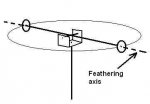Birdy, I stuck my head someplace where the sun doesn’t shine.
Cyclic flapping and cyclic feathering are the same thing viewed from different axes.
In forward flight, the rotor disc appears to blow back relative to the rotorhead.
Viewed along the axis of the rotorhead, the blades “flap,” but there’s no cyclic pitch change.
Viewed along the axis of the rotor disc, the blades cyclically “feather” but don’t flap. The amount of “feathering” in this axis is exactly equal to the amount of “flapping” observed when viewed along the rotorhead axis.
The mass about the feathering axis is forced to oscillate and resists by producing a 2/rev fore/aft shake of the stick.
None of which has anything to do with laying the stick over to the right. You’ve got me beat on that one.
Cyclic flapping and cyclic feathering are the same thing viewed from different axes.
In forward flight, the rotor disc appears to blow back relative to the rotorhead.
Viewed along the axis of the rotorhead, the blades “flap,” but there’s no cyclic pitch change.
Viewed along the axis of the rotor disc, the blades cyclically “feather” but don’t flap. The amount of “feathering” in this axis is exactly equal to the amount of “flapping” observed when viewed along the rotorhead axis.
The mass about the feathering axis is forced to oscillate and resists by producing a 2/rev fore/aft shake of the stick.
None of which has anything to do with laying the stick over to the right. You’ve got me beat on that one.

